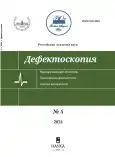Detection of hidden defects in composite material using the standing waves method
- Autores: Fedin K.V.1, Marilov O.K.2
-
Afiliações:
- Trofimuk Institute of Petroleum Geology and Geophysics SB RAS
- Novosibirsk State Technical University
- Edição: Nº 4 (2024)
- Páginas: 16-27
- Seção: Acoustic methods
- URL: https://bakhtiniada.ru/0130-3082/article/view/256349
- DOI: https://doi.org/10.31857/S0130308224040028
- ID: 256349
Citar
Texto integral
Resumo
As a result of the measurements carried out using the standing waves method, the hidden defects were detected inside the prosthetic feet details made of composite material. When comparing the obtained amplitude-frequency spectra of intact samples and samples with defects based on the first peaks corresponding to the first bending wave modes, it was revealed that the values of the resonant frequencies of defective samples were lower relative to the frequency values of the spectra of intact samples. That observation indicated that the material of defective products might have reduced strength characteristics. Also, when studying some samples, the presence of additional peaks was noted, which indicated the appearance of new reflection boundaries corresponding to the appearance of defects in the research samples. Maps of amplitude distributions in the studied samples were obtained. A preliminary comparison was made with the results of examining samples using the OmniScan X3 device manufactured by OLYMPUS. The results obtained indicate the presence of an increased number of reflection boundaries, as well as an increased content of bulges, which probably arise during the process of gluing products in a defective sample in comparison with a stronger one. The analysis confirms the possibility of successfully using the standing waves method as a method for detecting hidden defects in composite material.
Palavras-chave
Sobre autores
K. Fedin
Trofimuk Institute of Petroleum Geology and Geophysics SB RAS
Email: FedinKV@ipgg.sbras.ru
Rússia, Novosibirsk, Akademika Koptyuga Pr. 3, 630090
O. Marilov
Novosibirsk State Technical University
Autor responsável pela correspondência
Email: oleqmarilov@gmail.com
Rússia, Novosibirsk, Kirova str. 48, 630073
Bibliografia
- Zharova Yu.A. Review of methods for non-destructive testing of aircraft products made of polymer composite materials (in Russian) // Aktual'nyye problemy gumanitarnykh i yestestvennykh nauk (Current problems in the humanities and natural sciences). 2014. No. 1—1. P. 34—38.
- Samuilov A.O., Cherepanov I.S. Research of polymer composite materials using the shadow method of non-destructive testing (in Russian) // Zhiznennyy tsikl konstruktsionnykh materialov (Life cycle of structural materials). 2021. P. 239.
- Dikov I.A., Boychuk A.S., Chertishchev V.Yu., Dalin M.A., Generalov A.S. Experience in automated ultrasonic control of monolithic and cellular structures from PCM (in Russian) // Tsifrovyye tekhnologii, modelirovaniye i avtomatizatsiya protsessov nerazrushayushchego kontrolya v aerokosmicheskoy otrasli. Problemy i perspektivy vnedreniya (In Digital technologies, modeling and automation of non-destructive testing processes in the aerospace industry. Problems and prospect for implementation). 2021. P. 157—180.
- Boytsov B.V., Vasiliev S.L., Gromashev A.G., Yurgenson S.A. Non-destructive testing methods used for structures made of advanced composite materials (in Russian) // Trudy MAI (Proceedings of MAI). 2011. No. 49. P. 70.
- Sokolovskaya Yu.G., Podymova N.B., Karabutov A.A. Laser optical-acoustic method for quantitative assessment of the porosity of carbon fiber reinforced plastics based on measuring their acoustic impedance (in Russian) // Akusticheskij zhurnal (Journal of Acoustics). 2020. V. 66. No. 1. P. 86—94.
- Mohd Z.U., Vavilov V.P., Ariffin A.K. Ultrasonic infrared thermography in non-destructive testing (review) (in Russian) // Russian Journal of Nondestructive Testing. 2016. No. 4. P. 31—40.
- Vavilov V.P. Thermal non-destructive testing of materials and products (review) (in Russian) // Russian Journal of Nondestructive Testing. 2017. No. 10. P. 34—57.
- Rassykhaeva M.D., Chabanenko A.V. New intelligent flaw detection technologies for additive manufacturing (in Russian) // Metrologicheskoye obespecheniye innovatsionnykh tekhnologiy (In Metrological support of innovative technologies). 2022. P. 112—113.
- Demidov A.A., Krupnina O.A., Mikhailova N.A., Kosarina E.I. Study of samples made of polymer composite materials using X-ray computed tomography and processing of tomograms depicting the volume fraction of porosity (in Russian) // Trudy VIAM (Proceedings of VIAM). 2021. No. 5 (99). P. 105—113.
- Bulygin N.N. Modern non-destructive methods for control of critical products (in Russian) // Aktual'nyye napravleniya nauchnykh issledovaniy dlya effektivnogo razvitiya APK (Current areas of scientific research for the effective development of the agricultural industry). 2020. P. 211—214.
- Guseva D.V., Morozov V.V. Comparative analysis of methods for defectoscopy of composite materials (in Russian) // XXV Tupolevskiye chteniya (Shkola molodykh uchenykh) (XXV Tupolev Readings (School of Young Scientists)). 2021. P. 355—358.
- Kolesnikov Yu.I., Fedin K.V., Kargapolov A.A., Yemanov A.F. On diagnostics of the state of structural elements of structures based on the noise field (according to physical modeling data) (in Russian) // Journal of Mining Science. 2012. No. 1. P. 3—11.
- Fedin K.V., Kargapolov A.A., Kolesnikov Yu.I. The influence of slot-like defects on the field of standing waves formed in a fixed beam under the influence of acoustic noise (in Russian) // Interexpo Geo-Siberia. 2012. V. 1. No. 2. P. 88—92.
- Kolesnikov Yu.I., Fedin K.V., Kargapolov A.A., Yemanov A.F. On diagnosing loss of stability of pipeline supports based on acoustic noise (in Russian) // Journal of Mining Science. 2012. No. 4. P. 59—67.
- Fedin K.V., Klimontov V.V. A method for determining bone tissue density based on the isolation of standing waves from microseisms of the peripheral skeleton (in Russian) / RU Patent No. 2750976. 2021.
Arquivos suplementares









